Highly Efficient Heterogeneous Pd@POPs Catalyst for the N-Formylation of Amine and CO2
Abstract
1. Introduction
2. Results and Discussions
3. Conclusions
4. Materials and Methods
4.1. Material
4.2. Synthesis of PPh3-POP
4.3. Synthesis of Pd@POPs
4.4. Synthesis of Pd@SBA-15, Pd@Al2O3, and Pd@TiO2
4.5. A Typical Procedure for N-Formylation Reaction
4.6. Recycling Stability of Pd@POPs Catalyst
Supplementary Materials
Author Contributions
Funding
Data Availability Statement
Conflicts of Interest
References
- Li, K.; Peng, B.; Peng, T.Y. Recent Advances in Heterogeneous Photocatalytic CO2 Conversion to Solar Fuels. ACS Catal. 2016, 6, 7485–7527. [Google Scholar] [CrossRef]
- Salehizadeh, H.; Yan, N.; Farnood, R. Recent advances in microbial CO2 fixation and conversion to value-added products. Chem. Eng. J. 2020, 390, 124584. [Google Scholar] [CrossRef]
- Haszeldine, R.S. Carbon Capture and Storage: How Green Can Black Be? Science 2009, 325, 1647–1652. [Google Scholar] [CrossRef]
- Aresta, M.; Dibenedetto, A.; Angelini, A. Catalysis for the Valorization of Exhaust Carbon: From CO2 to Chemicals, Materials, and Fuels. Technological Use of CO2. Chem. Rev. 2014, 114, 1709–1742. [Google Scholar] [CrossRef] [PubMed]
- Yu, K.M.K.; Curcic, I.; Gabriel, J.; Tsang, S.C.E. Recent Advances in CO2 Capture and Utilization. ChemSusChem 2008, 1, 893–899. [Google Scholar] [CrossRef] [PubMed]
- Vidal, J.L.; Andrea, V.P.; MacQuarrie, S.L.; Kerton, F.M. Oxidized Biochar as a Simple, Renewable Catalyst for the Production of Cyclic Carbonates from Carbon Dioxide and Epoxides. ChemCatChem 2019, 11, 4089–4095. [Google Scholar] [CrossRef]
- Xiong, J.; Yang, R.X.; Xie, Y.; Huang, N.Y.; Zou, K.; Deng, W.Q. Formation of Cyclic Carbonates from CO2 and Epoxides Catalyzed by a Cobalt-Coordinated Conjugated Microporous Polymer. ChemCatChem 2017, 9, 2584–2587. [Google Scholar] [CrossRef]
- Wang, W.L.; Li, C.Y.; Yan, L.; Wang, Y.Q.; Jiang, M.; Ding, Y.J. Ionic Liquid/Zn-PPh3 Integrated Porous Organic Polymers Featuring Multifunctional Sites: Highly Active Heterogeneous Catalyst for Cooperative Conversion of CO2 to Cyclic Carbonates. ACS Catal. 2016, 6, 6091–6100. [Google Scholar] [CrossRef]
- Yang, Z.Z.; Chen, H.; Li, B.; Guo, W.; Jie, K.C.; Sun, Y.F.; Jiang, D.E.; Popovs, I.; Dai, S. Topotactic Synthesis of Phosphabenzene-Functionalized Porous Organic Polymers: Efficient Ligands in CO2 Conversion. Angew. Chem. Int. Ed. 2019, 58, 13763–13767. [Google Scholar] [CrossRef]
- Chen, B.C.; Bednarz, M.S.; Zhao, R.L.; Sundeen, J.E.; Chen, P.; Shen, Z.Q.; Skoumbourdis, A.P.; Barrish, J.C. A new facile method for the synthesis of 1-arylimidazole-5-carboxylates. Tetrahedron Lett. 2000, 41, 5453–5456. [Google Scholar] [CrossRef]
- Tohnishi, M.; Nakao, H.; Furuya, T.; Seo, A.; Kodama, H.; Tsubata, K.; Fujioka, S.; Kodama, H.; Hirooka, T.; Nishimatsu, T. Flubendiamide, a novel insecticide highly active against lepidopterous insect pests. J. Pestic. Sci. 2005, 30, 354–360. [Google Scholar] [CrossRef]
- Gerack, C.J.; McElwee-White, L. Formylation of amines. Molecules 2014, 19, 7689–7713. [Google Scholar] [CrossRef] [PubMed]
- Hauduc, C.; Belanger, G. General Approach toward Aspidospermatan-Type Alkaloids Using One-Pot Vilsmeier-Haack Cyclization and Azomethine Ylide Cycloaddition. J. Org. Chem. 2017, 82, 4703–4712. [Google Scholar] [CrossRef] [PubMed]
- Huang, W.X.; Zhang, Z.H. Manufacturing Method of Novel Liquid PUR (Poly Urethane Resin) Cleaner. CN Patent CN109135961-A, 2017. [Google Scholar]
- Zhang, L.; Han, Z.B.; Zhao, X.Y.; Wang, Z.; Ding, K.L. Highly Efficient Ruthenium-Catalyzed N-Formylation of Amines with H2 and CO2. Angew. Chem. Int. Ed. Engl. 2015, 54, 6186–6189. [Google Scholar] [CrossRef]
- Daw, P.; Chakraborty, S.; Leitus, G.; Diskin-Posner, Y.; Ben David, Y.; Milstein, D. Selective N-Formylation of Amines with H2 and CO2 Catalyzed by Cobalt Pincer Complexes. ACS Catal. 2017, 7, 2500–2504. [Google Scholar] [CrossRef]
- Dai, X.C.; Wang, B.; Wang, A.Q.; Shi, F. Amine formylation with CO2 and H2 catalyzed by heterogeneous Pd/PAL catalyst. Chin. J. Catal. 2019, 40, 1141–1146. [Google Scholar] [CrossRef]
- Mitsudome, T.; Urayama, T.; Fujita, S.; Maeno, Z.; Mizugaki, T.; Jitsukawa, K.; Kaneda, K. A Titanium Dioxide Supported Gold Nanoparticle Catalyst for the Selective N-Formylation of Functionalized Amines with Carbon Dioxide and Hydrogen. ChemCatChem 2017, 9, 3632–3636. [Google Scholar] [CrossRef]
- Ju, P.P.; Chen, J.Z.; Chen, A.B.; Chen, L.M.; Yu, Y.F. N-Formylation of Amines with CO2 and H2 Using Pd–Au Bimetallic Catalysts Supported on Polyaniline-Functionalized Carbon Nanotubes. ACS Sustain. Chem. Eng. 2017, 5, 2516–2528. [Google Scholar] [CrossRef]
- Kaur, P.; Hupp, J.T.; Nguyen, S.T. Porous Organic Polymers in Catalysis: Opportunities and Challenges. ACS Catal. 2011, 1, 819–835. [Google Scholar] [CrossRef]
- Yang, Z.Z.; Wang, H.; Ji, G.P.; Yu, X.X.; Yu, C.; Liu, X.W.; Wu, C.L.; Liu, Z.M. Pyridine-functionalized organic porous polymers: Applications in efficient CO2 adsorption and conversion. New. J. Chem. 2017, 41, 2869–2872. [Google Scholar] [CrossRef]
- Jiang, M.; Yan, L.; Ding, Y.J.; Sun, Q.; Liu, J.; Zhu, H.J.; Lin, R.H.; Xiao, F.S.; Jiang, Z.; Liu, J.Y. UltrasTable 3V-PPh3 polymers supported single Rh sites for fixed-bed hydroformylation of olefins. J. Mol. Catal. A Chem. 2015, 404, 211–217. [Google Scholar] [CrossRef]
- Li, C.Y.; Yan, L.; Lu, L.L.; Xiong, K.; Wang, W.L.; Jiang, M.; Liu, J.; Song, X.G.; Zhan, Z.P.; Jiang, Z.; et al. Single atom dispersed Rh-biphephos&PPh3@porous organic copolymers: Highly efficient catalysts for continuous fixed-bed hydroformylation of propene. Green Chem. 2016, 18, 2995–3005. [Google Scholar]
- Wang, Y.Q.; Yan, L.; Li, C.Y.; Jiang, M.; Zhao, Z.A.; Hou, G.J.; Ding, Y.J. Heterogeneous Rh/CPOL-BP&P(OPh)3 catalysts for hydroformylation of 1-butene: The formation and evolution of the active species. J. Catal. 2018, 368, 197–206. [Google Scholar]
- Wang, W.L.; Wang, Y.Q.; Li, C.Y.; Yan, L.; Jiang, M.; Ding, Y.J. State-of-the-Art Multifunctional Heterogeneous POP Catalyst for Cooperative Transformation of CO2 to Cyclic Carbonates. ACS Sustain. Chem. Eng. 2017, 5, 4523–4528. [Google Scholar] [CrossRef]
- Li, W.H.; Li, C.Y.; Li, Y.; Tang, H.T.; Wang, H.S.; Pan, Y.M.; Ding, Y.J. Palladium-metalated porous organic polymers as recyclable catalysts for chemoselective decarbonylation of aldehydes. Chem. Commun. 2018, 54, 8446–8449. [Google Scholar] [CrossRef] [PubMed]
- Chen, X.K.; Wang, W.L.; Zhu, H.J.; Yang, W.S.; Ding, Y.J. Pd0-PyPPh2 @porous organic polymer: Efficient heterogeneous nanoparticle catalyst for dehydrogenation of 3-methyl-2-cyclohexen-1-one without extra oxidants and hydrogen acceptors. Mol. Catal. 2018, 456, 49–56. [Google Scholar] [CrossRef]
- Kim, Y.J.; Lee, J.W.; Lee, H.J.; Zhang, S.Y.; Lee, J.S.; Cheong, M.; Kim, H.S. K3PO4-catalyzed carbonylation of amines to formamides. Appl. Catal. A Gen. 2015, 506, 126–133. [Google Scholar] [CrossRef]
- Luo, X.Y.; Zhang, H.Y.; Ke, Z.G.; Wu, C.L.; Guo, S.E.; Wu, Y.Y.; Yu, B.; Liu, Z.M. N-doped carbon supported Pd catalysts for N-formylation of amines with CO2/H2. Sci. China Chem. 2018, 61, 725–731. [Google Scholar] [CrossRef]
- Wang, Y.Y.; Chen, B.F.; Liu, S.L.; Shen, X.J.; Li, S.P.; Yang, Y.D.; Liu, H.Z.; Han, B.X. Methanol Promoted Palladium-Catalyzed Amine Formylation with CO2 and H2 by the Formation of HCOOCH3. ChemCatChem 2018, 10, 5124–5127. [Google Scholar] [CrossRef]
- Yu, X.X.; Yang, Z.Z.; Guo, S.E.; Liu, Z.H.; Zhang, H.Y.; Yu, B.; Zhao, Y.F.; Liu, Z.M. Mesoporous imine-based organic polymer: Catalyst-free synthesis in water and application in CO2 conversion. Chem. Commun. 2018, 54, 7633–7636. [Google Scholar] [CrossRef]
- Wang, G.Q.; Jiang, M.; Ji, G.J.; Sun, Z.; Li, C.Y.; Yan, L.; Ding, Y.J. Bifunctional Heterogeneous Ru/POP Catalyst Embedded with Alkali for the N-Formylation of Amine and CO2. ACS Sustain. Chem. Eng. 2020, 8, 5576–5583. [Google Scholar] [CrossRef]

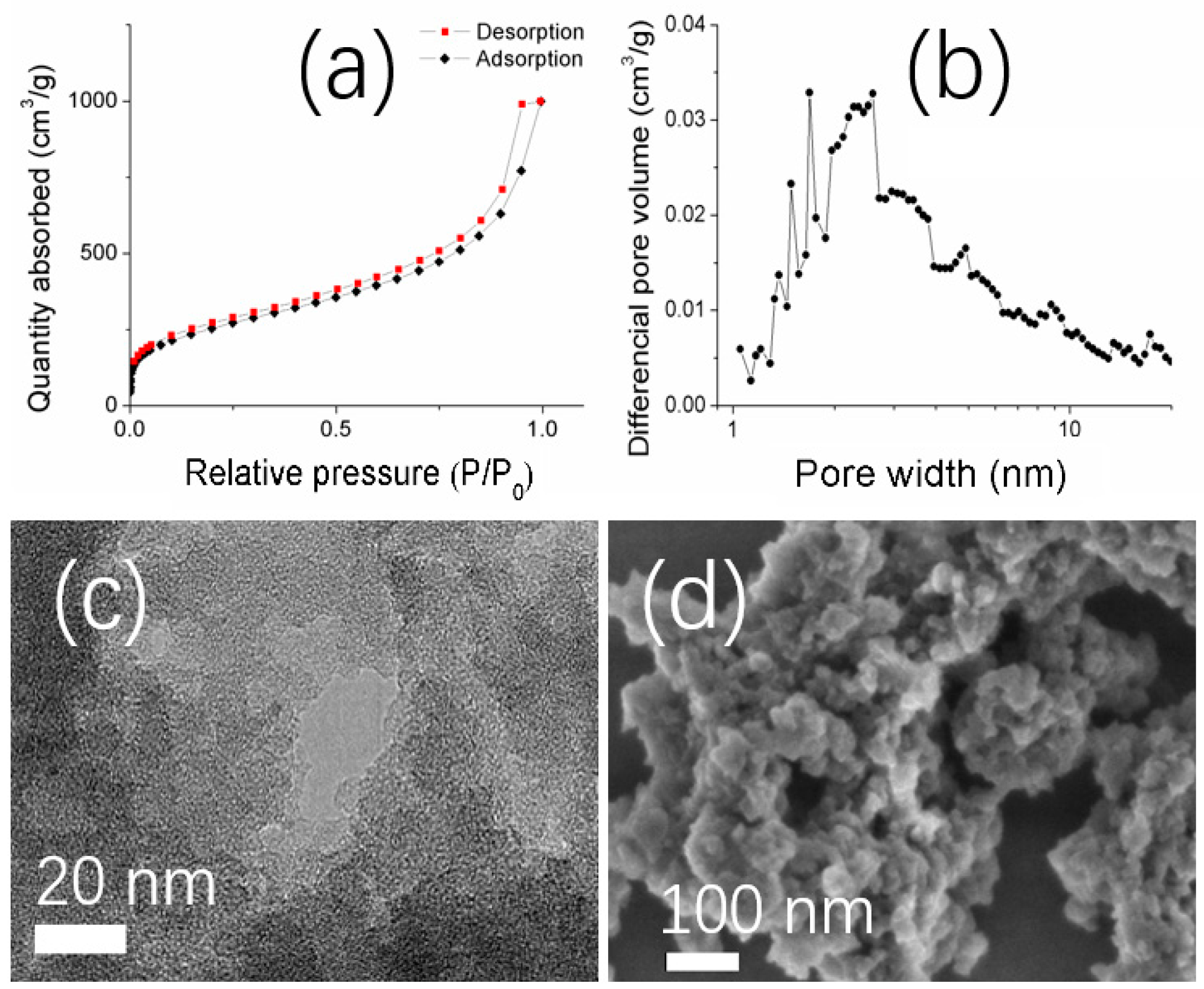
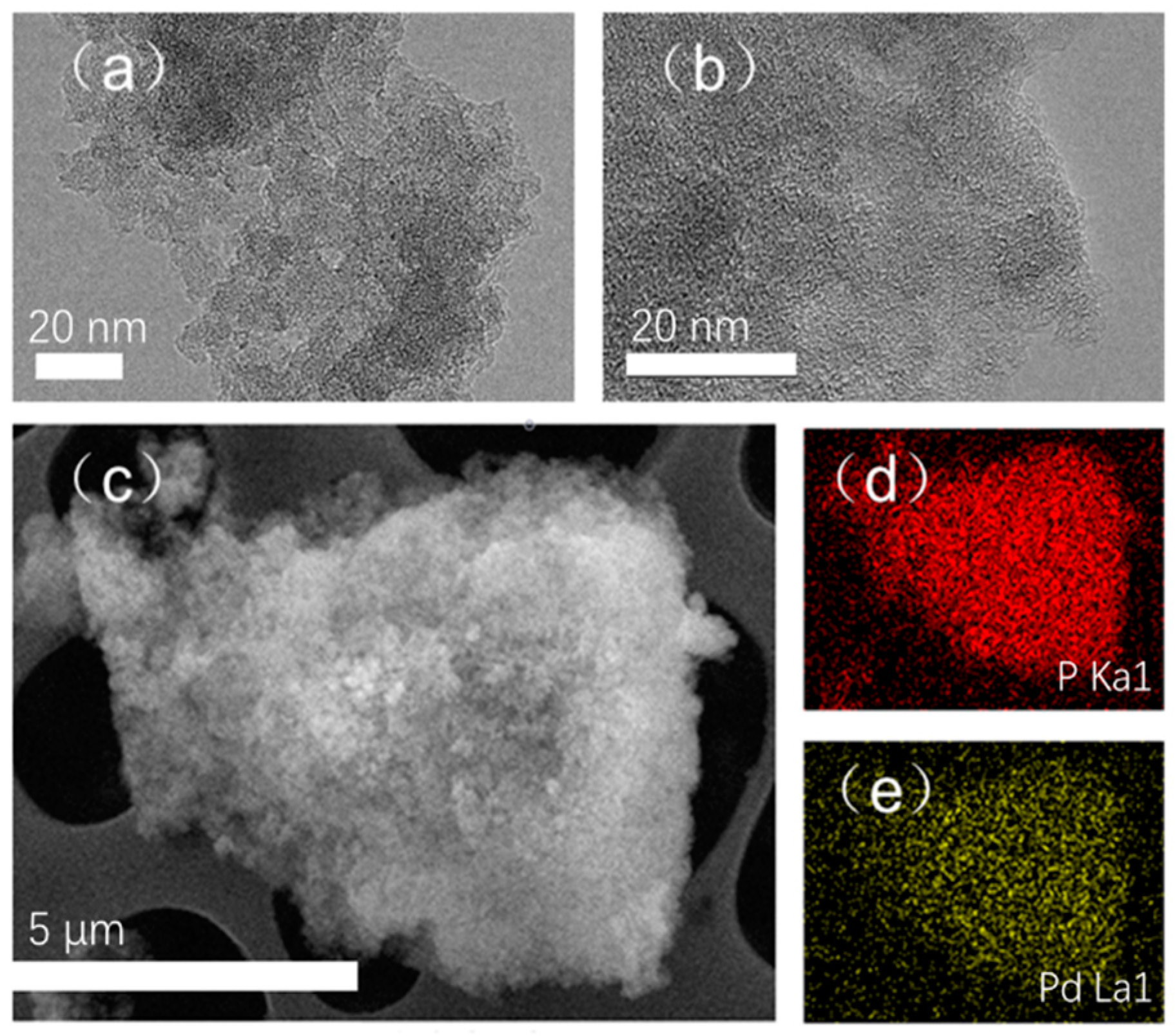
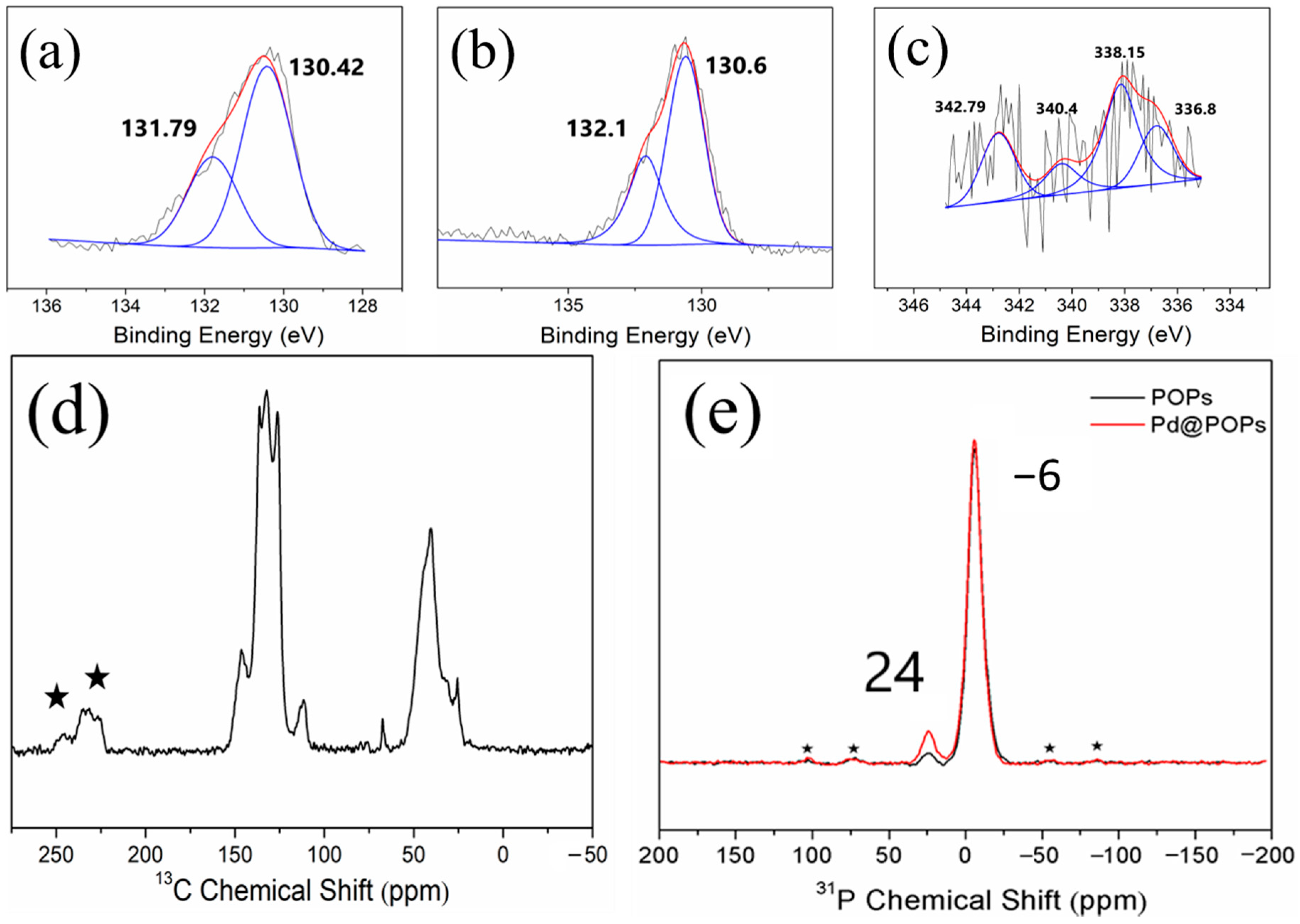
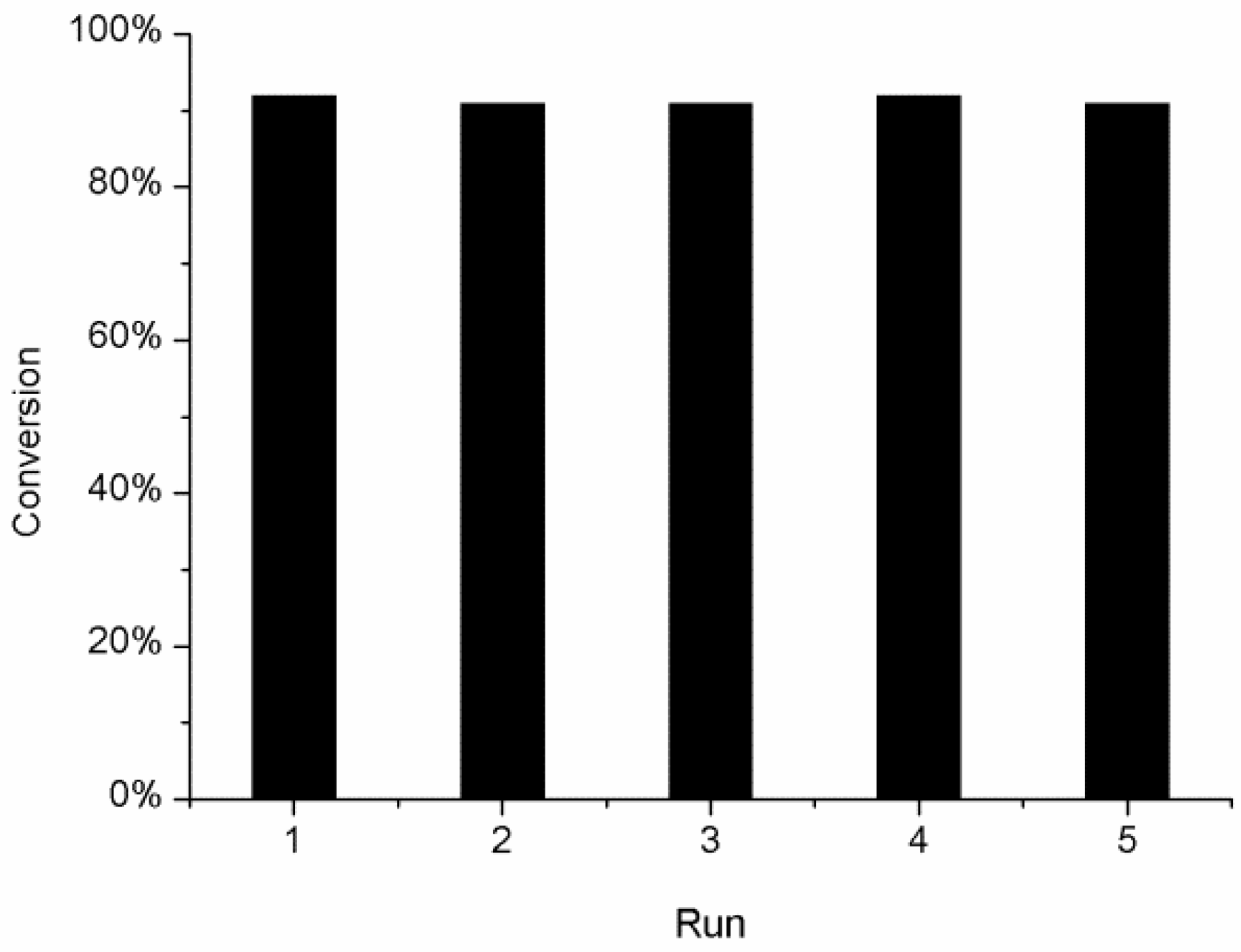
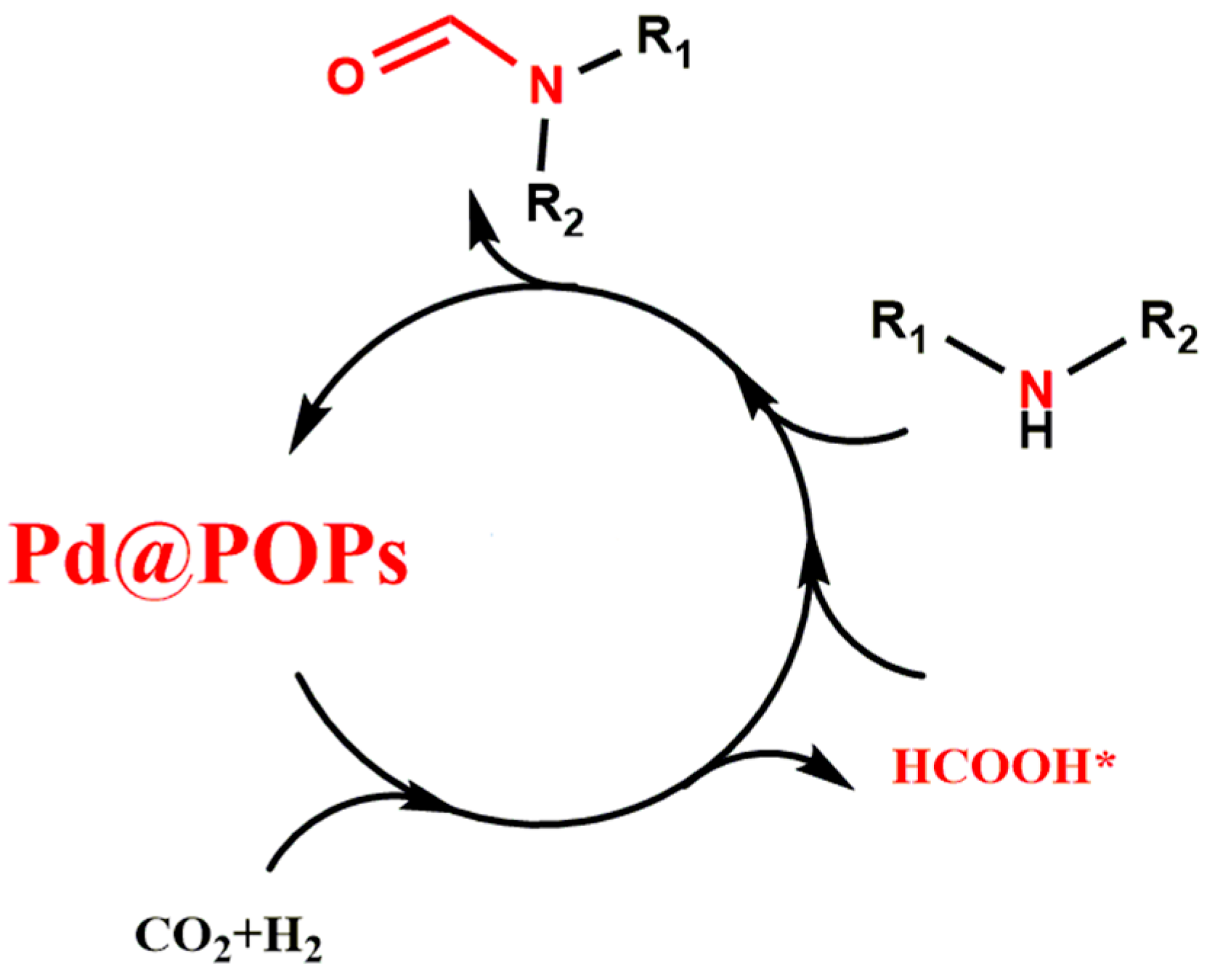

| Entry | Catalyst | Conv.% |
|---|---|---|
| 1 a | Pd(OAc)2 | 49 |
| 2 | Pd(OAc)2 | 92 |
| 3 | PdCl2 | 71 |
| 4 | RhCl3 | 11 |
| 5 | IrCl3 | 36 |
| 6 | Co(NO3)2 | 20 |
| Catalyst | CO2/H2/MPa | T/°C | Conv./% |
|---|---|---|---|
| Pd@POPs | 3/3 | 100 | 92/91 a |
| Pd@SBA-15 | 3/3 | 100 | 92/82 a |
| Pd@Al2O3 | 3/3 | 100 | 61 |
| Pd@TiO2 | 3/3 | 100 | 93/71 a |
| Pd@NC [29] | 3/4 | 130 | 93 |
| Pd/LDH [30] | 3/3 | 140 | 91.7 |
| Entry | Substrate | Product | Conv.% |
|---|---|---|---|
| 1 |  1a 1a |  1b 1b | 93 |
| 2 |  2a 2a |  2b 2b | 80 |
| 3 |  3a 3a |  3b 3b | 17 |
| 4 |  4a 4a |  4b 4b | 22 |
| 5 |  5a 5a |  5b 5b | 47 |
| 6 |  6a 6a |  6b 6b | 33 |
| 7 |  7a 7a |  7b 7b | 30 |
| 8 |  8a 8a |  8b 8b | 61 |
| 9 |  9a 9a |  9b 9b | 24 |
Publisher’s Note: MDPI stays neutral with regard to jurisdictional claims in published maps and institutional affiliations. |
© 2021 by the authors. Licensee MDPI, Basel, Switzerland. This article is an open access article distributed under the terms and conditions of the Creative Commons Attribution (CC BY) license (http://creativecommons.org/licenses/by/4.0/).
Share and Cite
Wang, G.; Jiang, M.; Ji, G.; Sun, Z.; Ma, L.; Li, C.; Du, H.; Yan, L.; Ding, Y. Highly Efficient Heterogeneous Pd@POPs Catalyst for the N-Formylation of Amine and CO2. Catalysts 2021, 11, 220. https://doi.org/10.3390/catal11020220
Wang G, Jiang M, Ji G, Sun Z, Ma L, Li C, Du H, Yan L, Ding Y. Highly Efficient Heterogeneous Pd@POPs Catalyst for the N-Formylation of Amine and CO2. Catalysts. 2021; 11(2):220. https://doi.org/10.3390/catal11020220
Chicago/Turabian StyleWang, Guoqing, Miao Jiang, Guangjun Ji, Zhao Sun, Lei Ma, Cunyao Li, Hong Du, Li Yan, and Yunjie Ding. 2021. "Highly Efficient Heterogeneous Pd@POPs Catalyst for the N-Formylation of Amine and CO2" Catalysts 11, no. 2: 220. https://doi.org/10.3390/catal11020220
APA StyleWang, G., Jiang, M., Ji, G., Sun, Z., Ma, L., Li, C., Du, H., Yan, L., & Ding, Y. (2021). Highly Efficient Heterogeneous Pd@POPs Catalyst for the N-Formylation of Amine and CO2. Catalysts, 11(2), 220. https://doi.org/10.3390/catal11020220






